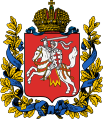State symbols
- Emblem of Belarus since 1995 (with minor modifications in 2012 and 2020)
- Coat of arms of Belarus (Pahonia) used between 1991 and 1995
- Emblem of the Byelorussian SSR (with modifications in 1937, 1938, 1949, 1958 and 1981)
- Coat of arms of Belarus as used on the passports of the Belarusian Democratic Republic from 1918
















































